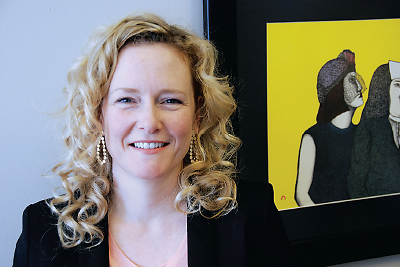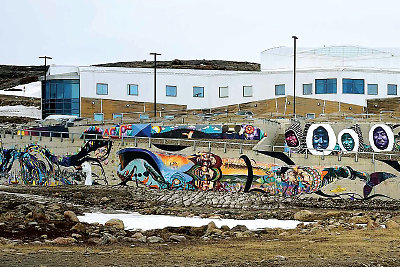Psychiatrists Work to Connect People in Arctic Canada to MH Care
Abstract
People with mental illness in Canada’s northernmost territory are able to access psychiatric services with the assistance of technology and dedicated clinicians.
Achieving Canada’s promise of health care for all can be challenging in the northernmost Canadian territory of Nunavut—where an estimated 35,000 people are scattered across 787,000 square miles.

The University of Toronto’s Allison Crawford, M.D., who is studying for her Ph.D. in English, makes extensive use of the arts as a transcultural tool in her work with the Inuit population in northern Canada.
However, thanks to a program connecting patients and providers on the ground in Arctic Canada to psychiatrists in southern territories, the people of Nunavut do have access to psychiatric care, according to Allison Crawford, M.D., director of the Northern Psychiatric Outreach program at the Centre for Addiction and Mental Health and an assistant professor of psychiatry at the University of Toronto.
The program’s catchment area is the northern reaches of Ontario and all of Nunavut, carved out of the Northwest Territories in 1999 as a self-governing territory for the Inuit people. According to the territory’s tourism website, “There are no roads to Nunavut. The 25 separate communities of Nunavut are not connected to each other by highway or by railroad, nor are they connected by road or rail to any other Canadian cities farther south.”
As a result, airplanes, usually small ones, offer the prime mode of transport, said Lisa Andermann, M.D., M.Phil., a consulting psychiatrist and associate professor at the University of Toronto and Mt. Sinai Hospital in Toronto. Three times a year, she flies north and spends a week in small communities outside the capital, Iqaluit, on Baffin Island.
There are health centers in each community in Nunavut, staffed mainly by nurses, although the University of Toronto team works only at sites on Baffin Island, said Andermann. The hospital in Iqaluit includes a mental health clinic but employs no on-site psychiatrist. So 10 psychiatrists like Andermann and Crawford from Toronto and other cities in the south of Canada fly up to Nunavut communities on regular schedules to provide care.
Once in the field, they evaluate new patients, follow up with existing cases, and monitor medication use and metabolic status, working closely with families, schools, local nurses, and social workers.
“Today, every community in Nunavut has a mental health nurse who does counseling and treatment monitoring,” Andermann told Psychiatric News. “They work closely with doctors. Very serious cases can be flown out to the south for treatment.”
According to Crawford, who worked in Iqaluit from 2009 to 2011 and now goes north four times a year for week-long trips, the local psychiatric nurses are a crucial link between doctors and patients. “They provide continuous care, and we provide indirect care, mostly through telepsychiatry,” Crawford told Psychiatric News.
Nunavut may be remote, but the uptake of technology in the territory has been strong, especially among young people, said Crawford.
The telepsychiatry element of the program began about 10 years ago and has been evolving along with computer technology ever since. Currently, the program is restructuring to provide more continuity of care by matching psychiatrists more closely with primary care clinicians.
“Our new project is based on a program developed at the University of New Mexico and will create more of a sense of team and more standardized care in these remote places,” said Crawford.

Mental health treatment at Qikiqtani General Hospital in Iqaluit, Nunavut Territory, is supported by visiting psychiatrists from Canada’s major cities.
She noted several challenges in providing psychiatric services over such distances. For one thing, the quality of the therapeutic relationship using telepsychiatry can vary, but it is improved if the psychiatrist has visited the community.
“It helps us to first connect and understand the local context,” Crawford said. “Then we can use telepsychiatry after the contacts have been established.”
Also, providing a full spectrum of interventions is more difficult in the north.
Telepsychiatry also helps augment provision of psychotherapy, which is limited by the short times the psychiatrists can spend in the north. In addition, prescribing choices are often constrained by the narrower range of medications available there.
Navigating Inuit culture has proved to be a step-by-step process, said Crawford.
“Early on, working through translators, we thought we were connecting with people, but then we found out that sometimes there are gaps in our understanding. One recent striking example is that sometimes the Inuktitut translation for schizophrenia is ‘rocks-in-the-head,’” she said. “It’s a complex issue; I don’t think we fully know yet how mental illness is understood.”
To bridge that gap, Crawford and colleagues have worked with anthropologists and anthropologically trained physicians like Andermann to keep the dialogue open, seeking to understand what illness means to their patients.
“Psychoeducation is important, but we must first ask what they are experiencing, how they understand it, how their family responds to it, and what they think is going on,” said Crawford. “This leads to a more open, fluid, narrative clinical encounter, which is useful in working with people of different cultures.”
In addition, mental health providers need to be aware of the impact that poverty, unemployment, overcrowded housing, limited educational opportunities, and childhood adversity and trauma have on the people of Nunavut.
“I am struck by how much the conditions under which people live affect their well-being,” said Crawford. “That has made me suspicious of concepts such as ‘resilience,’ because why are we promoting resilience for people to live in a way that just should not be? We can’t cure everything with psychiatry.”
Alleviating that distress is what motivates Crawford, Andermann, and their colleagues, and their compensation goes beyond the professional.
“This is a beautiful part of the world, and I have a chance to be connected with a frontier,” said Andermann. “It’s a bit of an adventure, and it’s very rewarding.” ■



